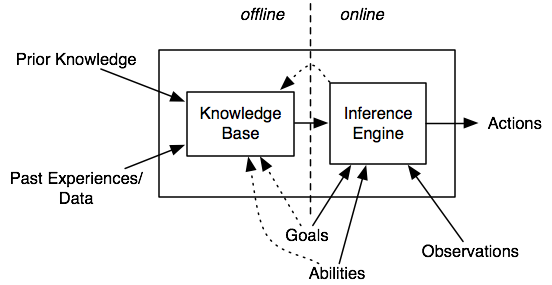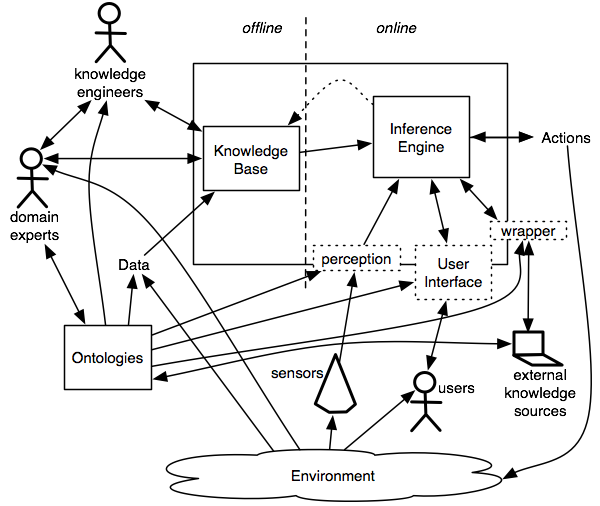Third edition of Artificial Intelligence: foundations of computational agents, Cambridge University Press, 2023 is now available (including the full text).
2.5 Acting with Reasoning
The previous sections assumed that an agent has some belief state that it maintains through time. For an intelligent agent, the belief state can be very complex, even for a single layer. Experience in studying and building intelligent agents has shown that an intelligent agent requires some internal representation of its belief state. Knowledge is the information about a domain that is used for solving problems in that domain. Knowledge can include general knowledge that can be applied to particular situations. Thus, it is more general than the beliefs about a specific state. A knowledge-based system is a system that uses knowledge about a domain to act or to solve problems.
Philosophers have defined knowledge as true, justified belief. AI researchers tend to use the terms knowledge and belief more interchangeably. Knowledge tends to mean general information that is taken to be true. Belief tends to mean information that can be revised based on new information. Often beliefs come with measures of how much they should be believed and models of how the beliefs interact. In an AI system, knowledge is typically not necessarily true and is justified only as being useful. This distinction often becomes blurry when one module of an agent may treat some information as true but another module may be able to revise that information.

Figure 2.9 shows a refinement of Figure 1.3 for a knowledge-based agent. A knowledge base is built offline and is used online to produce actions. This decomposition of an agent is orthogonal to the layered view of an agent; an intelligent agent requires both hierarchical organization and knowledge bases.
Online, when the agent is acting, the agent uses its knowledge base, its observations of the world, and its goals and abilities to choose what to do and to update its knowledge base. The knowledge base is its long-term memory, where it keeps the knowledge that is needed to act in the future. This knowledge comes from prior knowledge and is combined with what is learned from data and past experiences. The belief state is the short-term memory of the agent, which maintains the model of current environment needed between time steps. A clear distinction does not always exist between general knowledge and specific knowledge; for example, an outside delivery robot could learn general knowledge about a particular city. There is feedback from the inference engine to the knowledge base, because observing and acting in the world provide more data from which to learn.
Offline, before the agent has to act, it can build the knowledge base that is useful for it to act online. The role of the offline computation is to make the online computation more efficient or effective. The knowledge base is built from prior knowledge and from data of past experiences (either its own past experiences or data it has been given). Researchers have traditionally considered the case involving lots of data and little prior knowledge in the field of machine learning. The case of lots of prior knowledge and little or no data from which to learn has been studied under the umbrella of expert systems. However, for most non-trivial domains, the agent must use whatever information is available, and so it requires both rich prior knowledge and lots of data.
The goals and abilities are given offline, online, or both, depending on the agent. For example, a delivery robot could have general goals of keeping the lab clean and not damaging itself or other objects, but it could get other delivery goals at runtime. The online computation can be made more efficient if the knowledge base is tuned for the particular goals and abilities. However, this is often not possible when the goals and abilities are only available at runtime.

Figure 2.10 shows more detail of the interface between the agents and the world.



